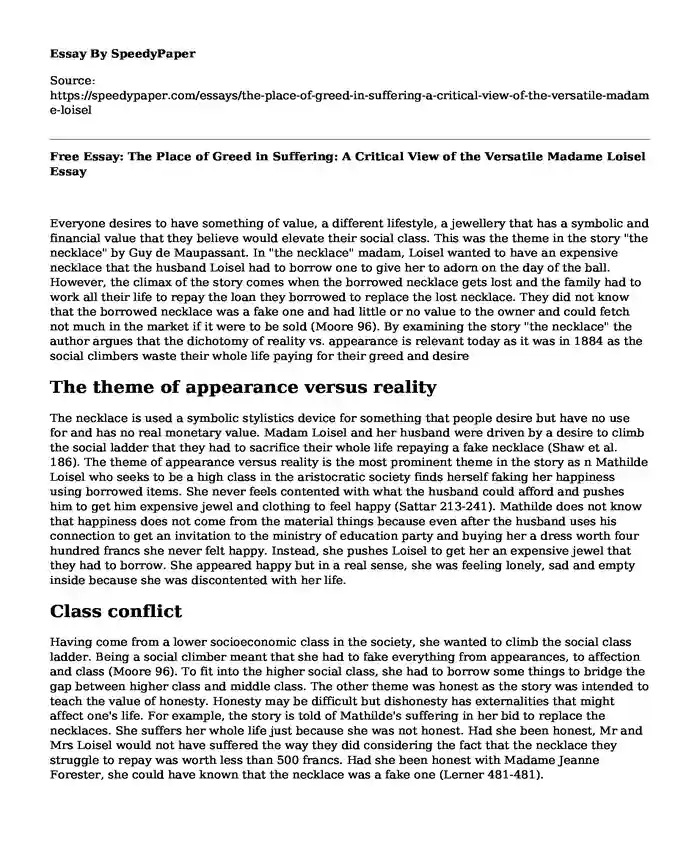
| Type of paper: | Research paper |
| Categories: | Literature |
| Pages: | 3 |
| Wordcount: | 765 words |
Everyone desires to have something of value, a different lifestyle, a jewellery that has a symbolic and financial value that they believe would elevate their social class. This was the theme in the story "the necklace" by Guy de Maupassant. In "the necklace" madam, Loisel wanted to have an expensive necklace that the husband Loisel had to borrow one to give her to adorn on the day of the ball. However, the climax of the story comes when the borrowed necklace gets lost and the family had to work all their life to repay the loan they borrowed to replace the lost necklace. They did not know that the borrowed necklace was a fake one and had little or no value to the owner and could fetch not much in the market if it were to be sold (Moore 96). By examining the story "the necklace" the author argues that the dichotomy of reality vs. appearance is relevant today as it was in 1884 as the social climbers waste their whole life paying for their greed and desire
The theme of appearance versus reality
The necklace is used a symbolic stylistics device for something that people desire but have no use for and has no real monetary value. Madam Loisel and her husband were driven by a desire to climb the social ladder that they had to sacrifice their whole life repaying a fake necklace (Shaw et al. 186). The theme of appearance versus reality is the most prominent theme in the story as n Mathilde Loisel who seeks to be a high class in the aristocratic society finds herself faking her happiness using borrowed items. She never feels contented with what the husband could afford and pushes him to get him expensive jewel and clothing to feel happy (Sattar 213-241). Mathilde does not know that happiness does not come from the material things because even after the husband uses his connection to get an invitation to the ministry of education party and buying her a dress worth four hundred francs she never felt happy. Instead, she pushes Loisel to get her an expensive jewel that they had to borrow. She appeared happy but in a real sense, she was feeling lonely, sad and empty inside because she was discontented with her life.
Class conflict
Having come from a lower socioeconomic class in the society, she wanted to climb the social class ladder. Being a social climber meant that she had to fake everything from appearances, to affection and class (Moore 96). To fit into the higher social class, she had to borrow some things to bridge the gap between higher class and middle class. The other theme was honest as the story was intended to teach the value of honesty. Honesty may be difficult but dishonesty has externalities that might affect one's life. For example, the story is told of Mathilde's suffering in her bid to replace the necklaces. She suffers her whole life just because she was not honest. Had she been honest, Mr and Mrs Loisel would not have suffered the way they did considering the fact that the necklace they struggle to repay was worth less than 500 francs. Had she been honest with Madame Jeanne Forester, she could have known that the necklace was a fake one (Lerner 481-481).
Conclusion
Written from an omniscient narrator perspective, the story explores how greed and dishonesty drove Mrs and Mrs Loisel to poverty and suffering trying to repay the necklaces for their whole life. Madame Loisel is portrayed as a versatile character as she morphs into the life of livery just as she blended with the upper class on the borrowed property. At the end of the story, she is presented as a lower class citizen that has tasted all the problems life has to offer the lower class people. The necklace is clearly the biggest example of symbolism in the story. The necklace for Madam Loisel symbolizes all that she does not have in life and all that she desires. The fact that it's fake, just makes it that much more symbolic of the greed and sacrifice that consumes Madam Loisel and her husband.
Works Cited
Lerner, G. "Review. Maupassant In The Hall Of Mirrors: Ironies Of Repetition In The Work Of Guy De Maupassant. Harris, Trevor A. Le V.." French Studies 45.4 (1991): 481-481. Web.
Moore, Olin H. "The Romanticism Of Guy De Maupassant." PMLA 33.1 (1918): 96. Web.
Sattar, Atia. "Certain Madness: Guy De Maupassant And Hypnotism." Configurations 19.2 (2011): 213-241. Web.
Shaw, David et al. "The Female Protagonist In The Nouvelles Of Madame De Villedieu." The Modern Language Review 90.1 (1995): 186. Web.
Cite this page
Free Essay: The Place of Greed in Suffering: A Critical View of the Versatile Madame Loisel. (2022, Jun 01). Retrieved from https://speedypaper.net/essays/the-place-of-greed-in-suffering-a-critical-view-of-the-versatile-madame-loisel
Request Removal
If you are the original author of this essay and no longer wish to have it published on the SpeedyPaper website, please click below to request its removal:
- Project Management Essay Example: The Move Plan and the Needs Analysis
- Essay Example on Capital Budgeting and Investment Decisions
- Free Essay Example on African Diaspora
- Contract Management Essay Example
- Notorious B.I.G Case Study - Free Essay for Everyone
- Work Rules! Insights From Google That Will Transform How You Live and Lead. Essay Example
- Paper Example on Manning University
Popular categories




